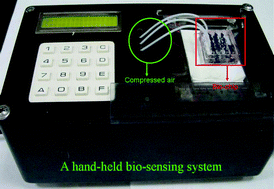A microfluidic device with an all-solid-state potentiometric biosensor array was developed using microfabrication technology. The sensor array included a pH indicator, and potassium and calcium ion-selective microelectrodes. The pH indicator was an iridium oxide thin film modified platinum microelectrode and the iridium oxide was deposited by an electrochemical method. The potassium and calcium ion-selective microelectrodes were platinum coated with silicon rubber based ion-selective membranes with respectively potassium (valinomycin) and calcium (ETH 1001) ionophores. The detection system was integrated with a micro-pneumatic pump which can continuously drive fluids into the microchannel through sensors at flow rates ranging from 52.4 µl min−1 to 7.67 µl min−1. The sensor array microfluidic device showed near-Nernstian responses with slopes of 62.62 mV ± 2.5 mV pH−1, 53.76 mV ± 3 mV −log[K+]−1 and 25.77 mV ± 2 mV −log[Ca2+]−1 at 25 °C ± 5 °C, and a linear response within the pH range of 2–10, with potassium and calcium concentrations between 0.1 M and 10−6 M. In this study the device provided a convenient way to measure the concentration of hydrogen, potassium and calcium ions, which are important physiological parameters

You have access to this article
 Please wait while we load your content...
Something went wrong. Try again?
Please wait while we load your content...
Something went wrong. Try again?


 Please wait while we load your content...
Please wait while we load your content...